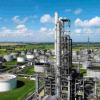I am currently doing a design project on production of methyl chloride. My task is the detailed design of a methanol recovery column that will recieve a mixture of large amount of water, some methanol and a very small amount of hydrogen chloride. The column will recieve this feed as a liquid from the 2nd reactor in a series of 2 (having been seperated from the product stream of methyl chloride and a small amount of dimethyl ether), and will then seperate the methanol from the other two components and feed it back to the first reactor.
However I am having a bit of trouble in terms of designing this column. I am not sure wether to treat it as a multicomponent or binary mixture (combining the water and HCl due to the amounts being so large and small respectively).
From a preliminary mass balance, the amount coming in to the recovery column is roughly as follows:-
Water: 20000kg/hr
Hydrogen Chloride: 60kg/hr
Methanol: 1600kg/hr
at 35oC
This however will more than likely change, but I can use it as a starting basis.
From here onwards I am unsure what to do. I know that the top product will need to be the methanol (and some water according to the preliminary balance), and the bottoms will be a mixture of of HCl and water (and probably some methanol) which will not be recovered, and become a waste stream. Since I am not concerned about the composition of the bottom stream, would it be fair to treat the distillation as binary, to perhaps use more simple calculation methods? Or is that not acceptable in terms of design.
What would be a good place to begin on the detailed design aspect of this column? At present I am looking at the heat loads assuming the pressure to be 1 atmosphere and the top temperature to be approx 70oC and the bottoms to be around the region of 80oC
I am getting nowhere though as I can't get my head around it all

 FB
FB












